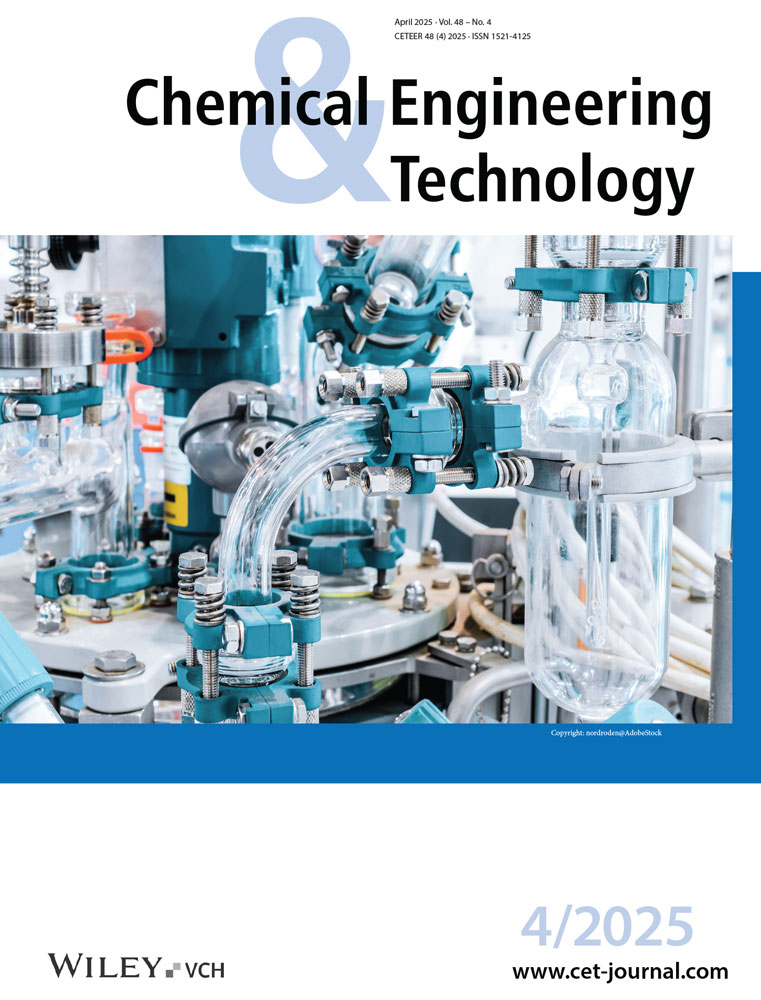Adsorption Study on Hexavalent Chromium Removal Using Magnetic Biochar from Ziziphus jujube Seed
Prathap Manthira Giri
Department of Civil Engineering, College of Engineering and Technology, SRM Institute of Science and Technology, Kattankulathur, Chengalpattu District, Tamil Nadu, 603203 India
Search for more papers by this authorCorresponding Author
Dr. Purushothaman Parathasarathy
Department of Civil Engineering, College of Engineering and Technology, SRM Institute of Science and Technology, Kattankulathur, Chengalpattu District, Tamil Nadu, 603203 India
E-mail: [email protected]
Search for more papers by this authorPrathap Manthira Giri
Department of Civil Engineering, College of Engineering and Technology, SRM Institute of Science and Technology, Kattankulathur, Chengalpattu District, Tamil Nadu, 603203 India
Search for more papers by this authorCorresponding Author
Dr. Purushothaman Parathasarathy
Department of Civil Engineering, College of Engineering and Technology, SRM Institute of Science and Technology, Kattankulathur, Chengalpattu District, Tamil Nadu, 603203 India
E-mail: [email protected]
Search for more papers by this authorAbstract
The study explores removal of hexavalent chromium (Cr(VI)) from wastewater using magnetic biochar (MB) from Ziziphus jujube seeds (ZJS). Modified biochar was characterized for functional groups, crystalline structure, morphological characteristics, surface area, elemental content, and magnetic properties. Batch experiments were conducted considering pH, initial chromium, adsorbent dosage, and contact time as controlling factors. The study demonstrates MB, with its high carbonization and magnetic saturation, effectively removes 98 % of hexavalent chromium from aqueous solutions. Langmuir and pseudo-second-order models were best fit models for adsorption, and 0.3 M HCl recovered more than 95 % of Cr(VI) than other concentrations.
References
- 1R. Juturu, R. Selvaraj, V. R. Murty, J. Water Process Eng. 2024, 66, 105908. DOI: https://doi.org/10.1016/j.jwpe.2024.105908
- 2P. Kumar, R. Rani, Y. Sumathi, N. Kumar, K. Chiu, W. Chen, A. K. Patel, C. Di Dong, Clean Technol. Environ. Policy 2024. DOI: https://doi.org/10.1007/s10098-024-02962-4
- 3M. B. Shakoor, U. Khalil, S. Ali, F. Sharif, S. R. Ahmad, M. Rizwan, A. Jilani, K. A. Al-Ghanim, P. K. Sarker, Environ. Pollut. Bioavailability 2024, 36 (1), 2368590. DOI: https://doi.org/10.1080/26395940.2024.2368590
10.1080/26395940.2024.2368590 Google Scholar
- 4M. Masuku, J. F. Nure, H. I. Atagana, N. Hlongwa, T. T. I. Nkambule, Sci. Total Environ. 2024, 908, 168136. DOI: https://doi.org/10.1016/j.scitotenv.2023.168136
- 5S. Kandasamy, S. Meenachi, K. Om Prakash, Kr. S. Kumar, V. Thamaraikannan, Appl. Res. 2023, 2 (5), 1–9. DOI: https://doi.org/10.1002/appl.202200093
10.1002/appl.202200093 Google Scholar
- 6G. Murtaza, M. Usman, Z. Ahmed, M. Rizwan, R. Iqbal, Environ. Pollut. Bioavailability 2024, 36 (1). DOI: https://doi.org/10.1080/26395940.2024.2387680
10.1080/26395940.2024.2387680 Google Scholar
- 7P. Manthira Giri, P. Parathasarathy, Chem. Eng. Technol. 2024, 47 (8), 1157–1164. DOI: https://doi.org/10.1002/ceat.202300332
- 8J. Shang, J. Pi, M. Zong, Y. Wang, W. Li, Q. Liao, J. Taiwan Inst. Chem. Eng. 2016, 68, 289–294. DOI: https://doi.org/10.1016/j.jtice.2016.09.012
- 9A. K. Giri, R. Patel, S. Mandal, Chem. Eng. J. 2012, 185–186, 71–81. DOI: https://doi.org/10.1016/j.cej.2012.01.025
- 10A. S. Yusuff, L. T. Popoola, A. I. Igbafe, Chem. Eng. Res. Des. 2022, 182, 592–603. DOI: https://doi.org/10.1016/j.cherd.2022.04.007
- 11D. Prabu, P. S. Kumar, B. S. Rathi, S. Sathish, K. V. Anand, J. A. Kumar, O. B. Mohammed, P. Silambarasan, Environ. Res. 2022, 203, 111813. DOI: https://doi.org/10.1016/j.envres.2021.111813
- 12C. Santhosh, E. Daneshvar, K. M. Tripathi, P. Baltrėnas, T. Y. Kim, E. Baltrėnaitė, A. Bhatnagar, Environ. Sci. Pollut. Res. 2020, 27 (26), 32874–32887. DOI: https://doi.org/10.1007/s11356-020-09275-1
- 13L. Frolova, M. Kharytonov, Adv. Mater. Sci. Eng. 2019, 2019, 2187132. DOI: https://doi.org/10.1155/2019/21871321
- 14B. Mahanty, S. Mondal, Arabian J. Sci. Eng. 2021, 46 (11), 10803–10818. DOI: https://doi.org/10.1007/s13369-021-05572-0
- 15T. Ravi, S. Sundararaman, Rasayan J. Chem. 2021, 14 (02), 1105–1109. DOI: https://doi.org/10.31788/RJC.2021.1426220
- 16X. Zhang, L. Lv, Y. Qin, M. Xu, X. Jia, Z. Chen, Bioresour. Technol. 2018, 256, 1–10. DOI: https://doi.org/10.1016/j.biortech.2018.01.145
- 17Jyoti, S. Singh, S. Das, S. Srivastava, Environ. Technol. Innov. 2023, 32, 103310. DOI: https://doi.org/10.1016/j.eti.2023.103310
- 18P. Manthira Giri, P. Parthasarathy, Sep. Sci. Technol. 2024, 59 (16), 1550–1570. DOI: https://doi.org/10.1080/01496395.2024.2394476
- 19J. Gao, Y. Liu, X. Li, M. Yang, J. Wang, Y. Chen, Sci. Rep. 2020, 10 (1), 1–13. DOI: https://doi.org/10.1038/s41598-020-64191-1
- 20M. G. Prathap, P. Purushothaman, Lecture Notes in Civil Engineering, vol. 333 (Eds: S. K. J. Rafid Al Khaddar, S. K. Singh, N. D. Kaushika, R. K. Tomar), Springer Nature Singapore, Singapore 2023.
- 21H. Chaudhary, J. Dinakaran, T. Notup, K. Vikram, K. S. Rao, Environ. Manage. 2024, 73 (2), 408–424. DOI: https://doi.org/10.1007/s00267-023-01866-1
- 22H. Luo, F. Fu, B. Tang, Colloids Surfaces A Physicochem. Eng. Aspects 2023, 670, 131538. DOI: https://doi.org/10.1016/j.colsurfa.2023.131538
- 23X. Zhang, L. Lv, Y. Qin, M. Xu, X. Jia, Z. Chen, Bioresour. Technol. 2018, 256, 1–10. DOI: https://doi.org/10.1016/j.biortech.2018.01.145
- 24O. Xin, H. Yitong, C. Xi, C. Jiawei, Water Sci. Technol. 2017, 75 (5), 1177–1184. DOI: https://doi.org/10.2166/wst.2016.610
- 25M. Liang, Y. Ding, Q. Zhang, D. Wang, H. Li, L. Lu, Sci. Rep. 2020, 10 (1), 1–13. DOI: https://doi.org/10.1038/s41598-020-78142-3
- 26Z. Tan, J. Zou, L. Zhang, Q. Huang, J. Mater. Cycles Waste Manage. 2018, 20 (2), 1036–1049. DOI: https://doi.org/10.1007/s10163-017-0666-5
- 27Y. Feng, Y. Du, Z. Chen, M. Du, K. Yang, X. Lv, Z. Li, J. Coatings Technol. Res. 2018, 15 (5), 1145–1155. DOI: https://doi.org/10.1007/s11998-018-0052-9
- 28Y. Chen, B. Wang, J. Xin, P. Sun, D. Wu, Ecotoxicol. Environ. Saf. 2018, 164, 440–447. DOI: https://doi.org/10.1016/j.ecoenv.2018.08.024
- 29K. Govindaraju, R. Vinu, R. Gautam, R. Vasantharaja, M. Niranjan, I. Sundar, Biomass Convers. Biorefinery 2024, 14, 3643–3653. DOI: https://doi.org/10.1007/s13399-022-02512-2
- 30Y. Zhang, Y. Tang, R. Yan, J. Li, C. Li, S. Liang, Environ. Sci. Pollut. Res. 2023, 30, 97310–97318. DOI: https://doi.org/10.1007/s11356-023-28603-9
- 31B. Manimekalai, S. Sivanesan, P. S. Kumar, Adsorpt. Sci. Technol. 2023, 2023, 1643981. DOI: https://doi.org/10.1155/2023/1643981
- 32Z. Yin, S. Xu, S. Liu, S. Xu, J. Li, Y. Zhang, Bioresour. Technol. 2020, 300, 122680. DOI: https://doi.org/10.1016/j.biortech.2019.122680
- 33J. Bayuo, M. A. Abukari, K. B. Pelig-Ba, Appl. Water Sci. 2020, 10 (7), 1–6. DOI: https://doi.org/10.1007/s13201-020-01250-y
- 34K. Anbalagan, P. S. Kumar, R. Karthikeyan, Desalin. Water Treat. 2016, 57 (27), 12585–12607. DOI: https://doi.org/10.1080/19443994.2015.1049965




